Declining Philanthropic Contribution to Nonprofits - Dissertation
VerifiedAdded on 2023/06/14
|20
|4663
|355
Thesis and Dissertation
AI Summary
This dissertation proposal explores the reasons behind the declining philanthropic contributions by U.S. corporations to nonprofit organizations and the detrimental impact this decline has on these organizations. The research employs a qualitative case study approach, utilizing face-to-face interviews with managers of selected U.S. nonprofit companies. The study aims to gather in-depth information on the factors contributing to the decline in corporate philanthropy and its consequences for nonprofits. Data analysis involves pattern matching, explanation building, and cross-case evaluation to identify key themes related to constructing corporate philanthropy, the impacts of decreasing contributions, and ways to enhance philanthropic practices. The research design includes considerations for data reliability, validity, and ethical assurances, ensuring honest and unbiased responses from participants. Limitations and assumptions are acknowledged to provide a comprehensive understanding of the research findings, with the goal of encouraging companies to improve or implement philanthropic actions for reciprocal survival. Desklib provides access to similar documents and AI-powered study tools.
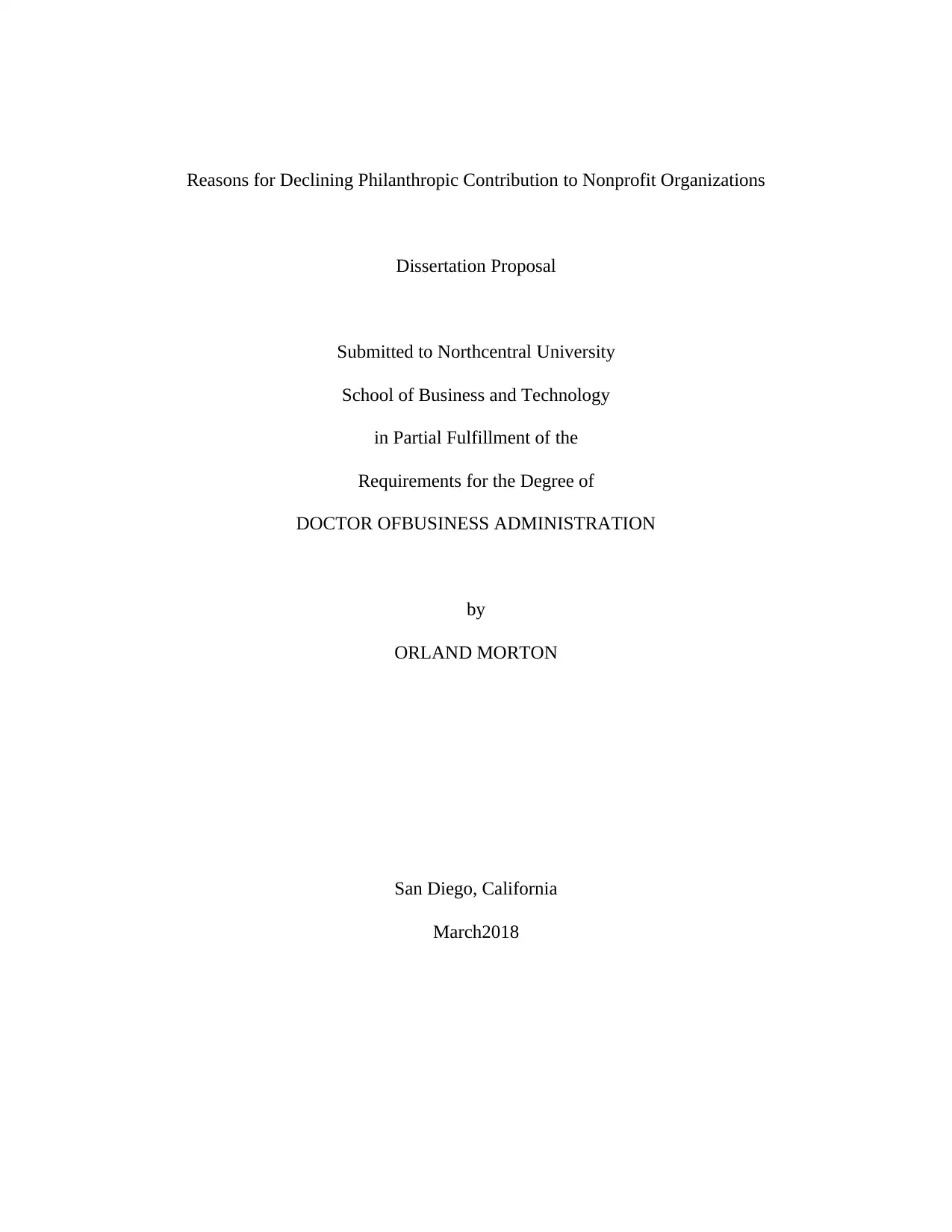
Reasons for Declining Philanthropic Contribution to Nonprofit Organizations
Dissertation Proposal
Submitted to Northcentral University
School of Business and Technology
in Partial Fulfillment of the
Requirements for the Degree of
DOCTOR OFBUSINESS ADMINISTRATION
by
ORLAND MORTON
San Diego, California
March2018
Dissertation Proposal
Submitted to Northcentral University
School of Business and Technology
in Partial Fulfillment of the
Requirements for the Degree of
DOCTOR OFBUSINESS ADMINISTRATION
by
ORLAND MORTON
San Diego, California
March2018
Paraphrase This Document
Need a fresh take? Get an instant paraphrase of this document with our AI Paraphraser
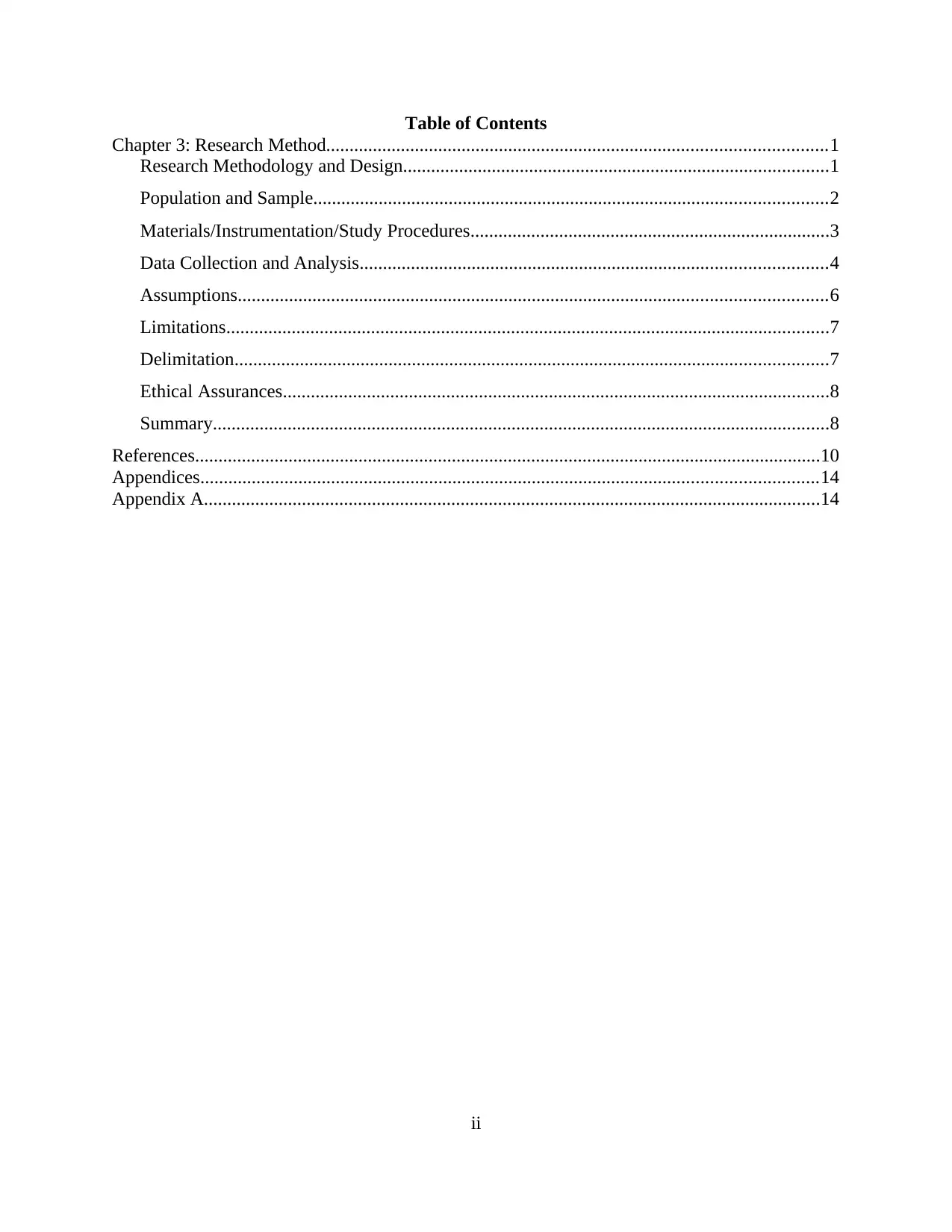
Table of Contents
Chapter 3: Research Method...........................................................................................................1
Research Methodology and Design...........................................................................................1
Population and Sample..............................................................................................................2
Materials/Instrumentation/Study Procedures.............................................................................3
Data Collection and Analysis....................................................................................................4
Assumptions..............................................................................................................................6
Limitations.................................................................................................................................7
Delimitation...............................................................................................................................7
Ethical Assurances.....................................................................................................................8
Summary....................................................................................................................................8
References......................................................................................................................................10
Appendices....................................................................................................................................14
Appendix A....................................................................................................................................14
ii
Chapter 3: Research Method...........................................................................................................1
Research Methodology and Design...........................................................................................1
Population and Sample..............................................................................................................2
Materials/Instrumentation/Study Procedures.............................................................................3
Data Collection and Analysis....................................................................................................4
Assumptions..............................................................................................................................6
Limitations.................................................................................................................................7
Delimitation...............................................................................................................................7
Ethical Assurances.....................................................................................................................8
Summary....................................................................................................................................8
References......................................................................................................................................10
Appendices....................................................................................................................................14
Appendix A....................................................................................................................................14
ii

List of Tables
Table 1: Factors constructing Corporate Philanthropy
iii
Table 1: Factors constructing Corporate Philanthropy
iii
⊘ This is a preview!⊘
Do you want full access?
Subscribe today to unlock all pages.

Trusted by 1+ million students worldwide
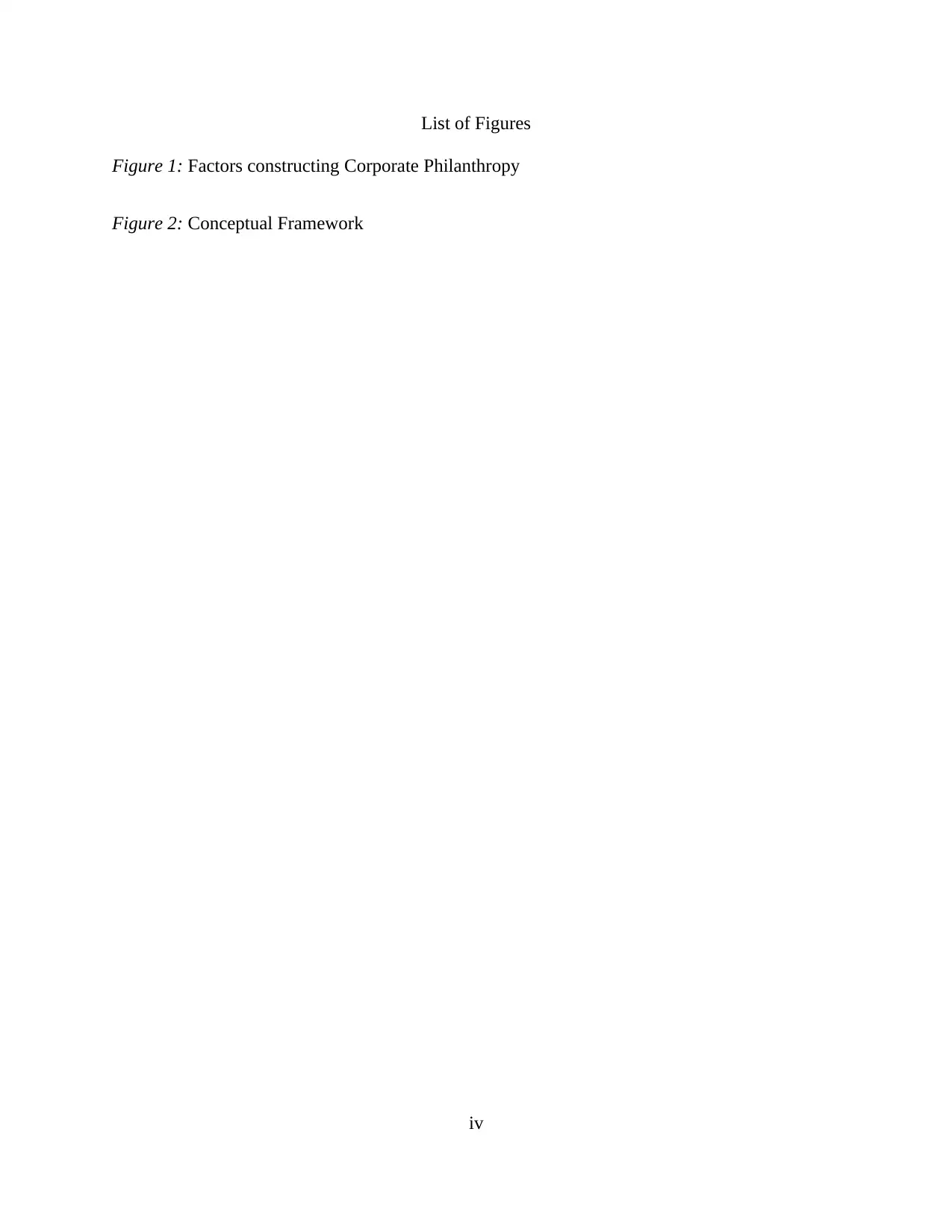
List of Figures
Figure 1: Factors constructing Corporate Philanthropy
Figure 2: Conceptual Framework
iv
Figure 1: Factors constructing Corporate Philanthropy
Figure 2: Conceptual Framework
iv
Paraphrase This Document
Need a fresh take? Get an instant paraphrase of this document with our AI Paraphraser
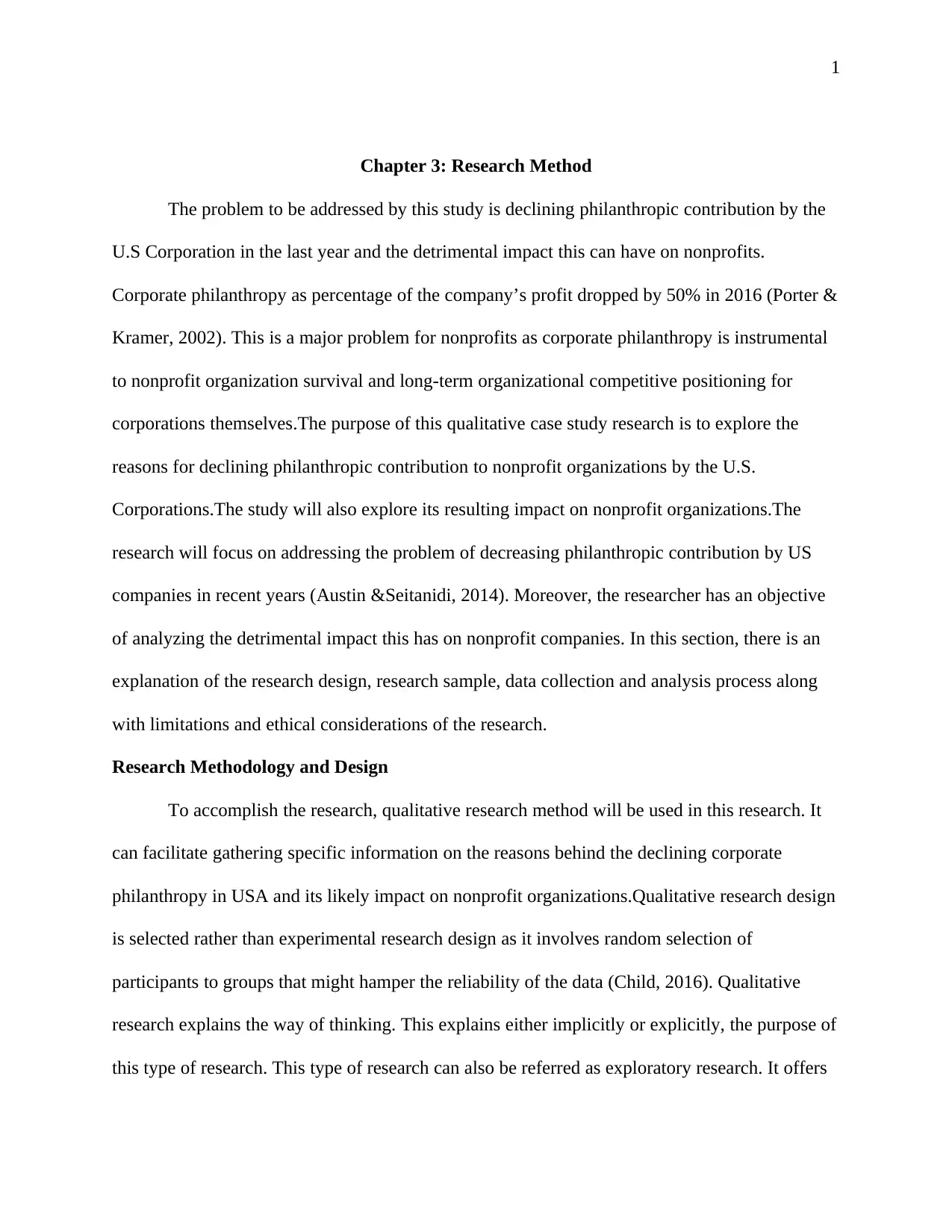
1
Chapter 3: Research Method
The problem to be addressed by this study is declining philanthropic contribution by the
U.S Corporation in the last year and the detrimental impact this can have on nonprofits.
Corporate philanthropy as percentage of the company’s profit dropped by 50% in 2016 (Porter &
Kramer, 2002). This is a major problem for nonprofits as corporate philanthropy is instrumental
to nonprofit organization survival and long-term organizational competitive positioning for
corporations themselves.The purpose of this qualitative case study research is to explore the
reasons for declining philanthropic contribution to nonprofit organizations by the U.S.
Corporations.The study will also explore its resulting impact on nonprofit organizations.The
research will focus on addressing the problem of decreasing philanthropic contribution by US
companies in recent years (Austin &Seitanidi, 2014). Moreover, the researcher has an objective
of analyzing the detrimental impact this has on nonprofit companies. In this section, there is an
explanation of the research design, research sample, data collection and analysis process along
with limitations and ethical considerations of the research.
Research Methodology and Design
To accomplish the research, qualitative research method will be used in this research. It
can facilitate gathering specific information on the reasons behind the declining corporate
philanthropy in USA and its likely impact on nonprofit organizations.Qualitative research design
is selected rather than experimental research design as it involves random selection of
participants to groups that might hamper the reliability of the data (Child, 2016). Qualitative
research explains the way of thinking. This explains either implicitly or explicitly, the purpose of
this type of research. This type of research can also be referred as exploratory research. It offers
Chapter 3: Research Method
The problem to be addressed by this study is declining philanthropic contribution by the
U.S Corporation in the last year and the detrimental impact this can have on nonprofits.
Corporate philanthropy as percentage of the company’s profit dropped by 50% in 2016 (Porter &
Kramer, 2002). This is a major problem for nonprofits as corporate philanthropy is instrumental
to nonprofit organization survival and long-term organizational competitive positioning for
corporations themselves.The purpose of this qualitative case study research is to explore the
reasons for declining philanthropic contribution to nonprofit organizations by the U.S.
Corporations.The study will also explore its resulting impact on nonprofit organizations.The
research will focus on addressing the problem of decreasing philanthropic contribution by US
companies in recent years (Austin &Seitanidi, 2014). Moreover, the researcher has an objective
of analyzing the detrimental impact this has on nonprofit companies. In this section, there is an
explanation of the research design, research sample, data collection and analysis process along
with limitations and ethical considerations of the research.
Research Methodology and Design
To accomplish the research, qualitative research method will be used in this research. It
can facilitate gathering specific information on the reasons behind the declining corporate
philanthropy in USA and its likely impact on nonprofit organizations.Qualitative research design
is selected rather than experimental research design as it involves random selection of
participants to groups that might hamper the reliability of the data (Child, 2016). Qualitative
research explains the way of thinking. This explains either implicitly or explicitly, the purpose of
this type of research. This type of research can also be referred as exploratory research. It offers
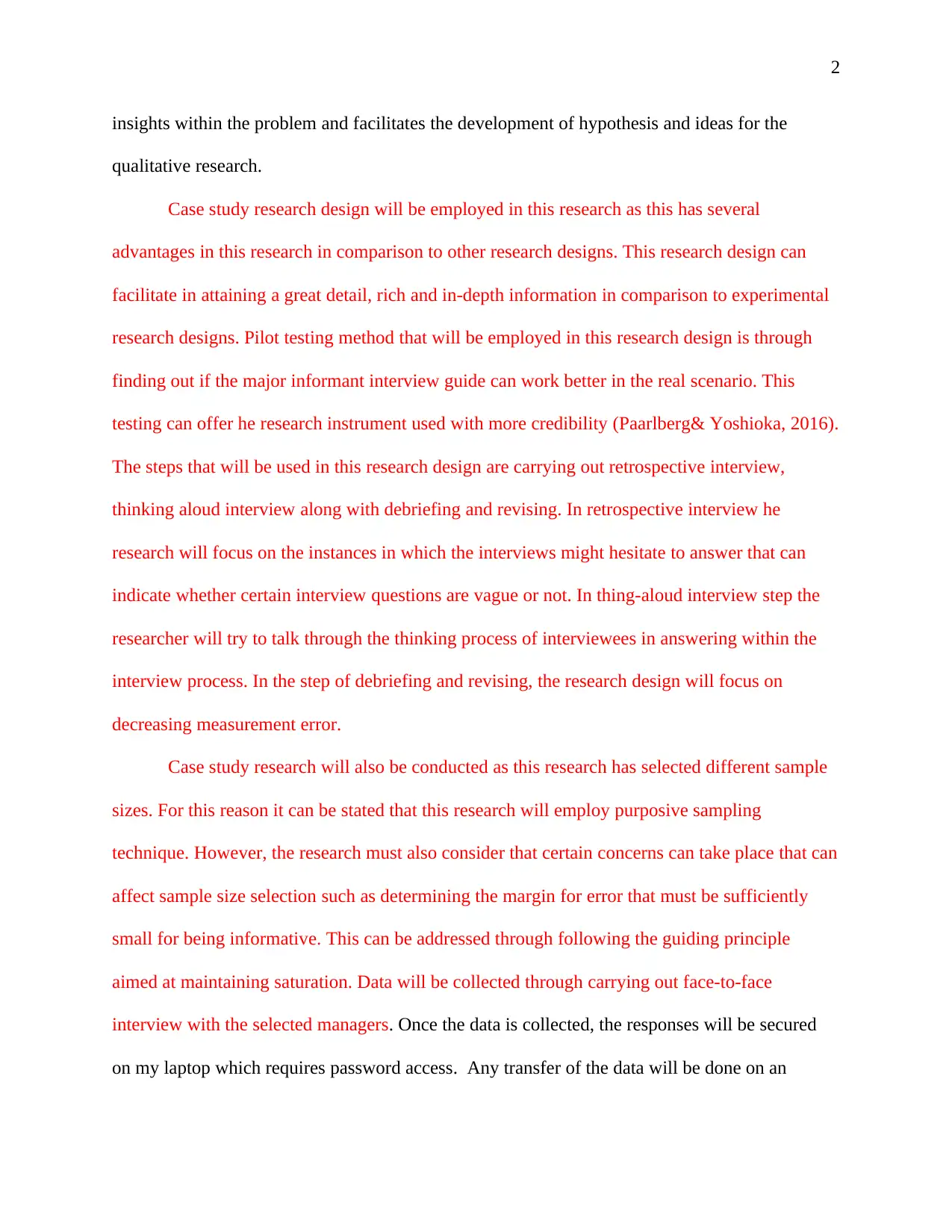
2
insights within the problem and facilitates the development of hypothesis and ideas for the
qualitative research.
Case study research design will be employed in this research as this has several
advantages in this research in comparison to other research designs. This research design can
facilitate in attaining a great detail, rich and in-depth information in comparison to experimental
research designs. Pilot testing method that will be employed in this research design is through
finding out if the major informant interview guide can work better in the real scenario. This
testing can offer he research instrument used with more credibility (Paarlberg& Yoshioka, 2016).
The steps that will be used in this research design are carrying out retrospective interview,
thinking aloud interview along with debriefing and revising. In retrospective interview he
research will focus on the instances in which the interviews might hesitate to answer that can
indicate whether certain interview questions are vague or not. In thing-aloud interview step the
researcher will try to talk through the thinking process of interviewees in answering within the
interview process. In the step of debriefing and revising, the research design will focus on
decreasing measurement error.
Case study research will also be conducted as this research has selected different sample
sizes. For this reason it can be stated that this research will employ purposive sampling
technique. However, the research must also consider that certain concerns can take place that can
affect sample size selection such as determining the margin for error that must be sufficiently
small for being informative. This can be addressed through following the guiding principle
aimed at maintaining saturation. Data will be collected through carrying out face-to-face
interview with the selected managers. Once the data is collected, the responses will be secured
on my laptop which requires password access. Any transfer of the data will be done on an
insights within the problem and facilitates the development of hypothesis and ideas for the
qualitative research.
Case study research design will be employed in this research as this has several
advantages in this research in comparison to other research designs. This research design can
facilitate in attaining a great detail, rich and in-depth information in comparison to experimental
research designs. Pilot testing method that will be employed in this research design is through
finding out if the major informant interview guide can work better in the real scenario. This
testing can offer he research instrument used with more credibility (Paarlberg& Yoshioka, 2016).
The steps that will be used in this research design are carrying out retrospective interview,
thinking aloud interview along with debriefing and revising. In retrospective interview he
research will focus on the instances in which the interviews might hesitate to answer that can
indicate whether certain interview questions are vague or not. In thing-aloud interview step the
researcher will try to talk through the thinking process of interviewees in answering within the
interview process. In the step of debriefing and revising, the research design will focus on
decreasing measurement error.
Case study research will also be conducted as this research has selected different sample
sizes. For this reason it can be stated that this research will employ purposive sampling
technique. However, the research must also consider that certain concerns can take place that can
affect sample size selection such as determining the margin for error that must be sufficiently
small for being informative. This can be addressed through following the guiding principle
aimed at maintaining saturation. Data will be collected through carrying out face-to-face
interview with the selected managers. Once the data is collected, the responses will be secured
on my laptop which requires password access. Any transfer of the data will be done on an
⊘ This is a preview!⊘
Do you want full access?
Subscribe today to unlock all pages.

Trusted by 1+ million students worldwide
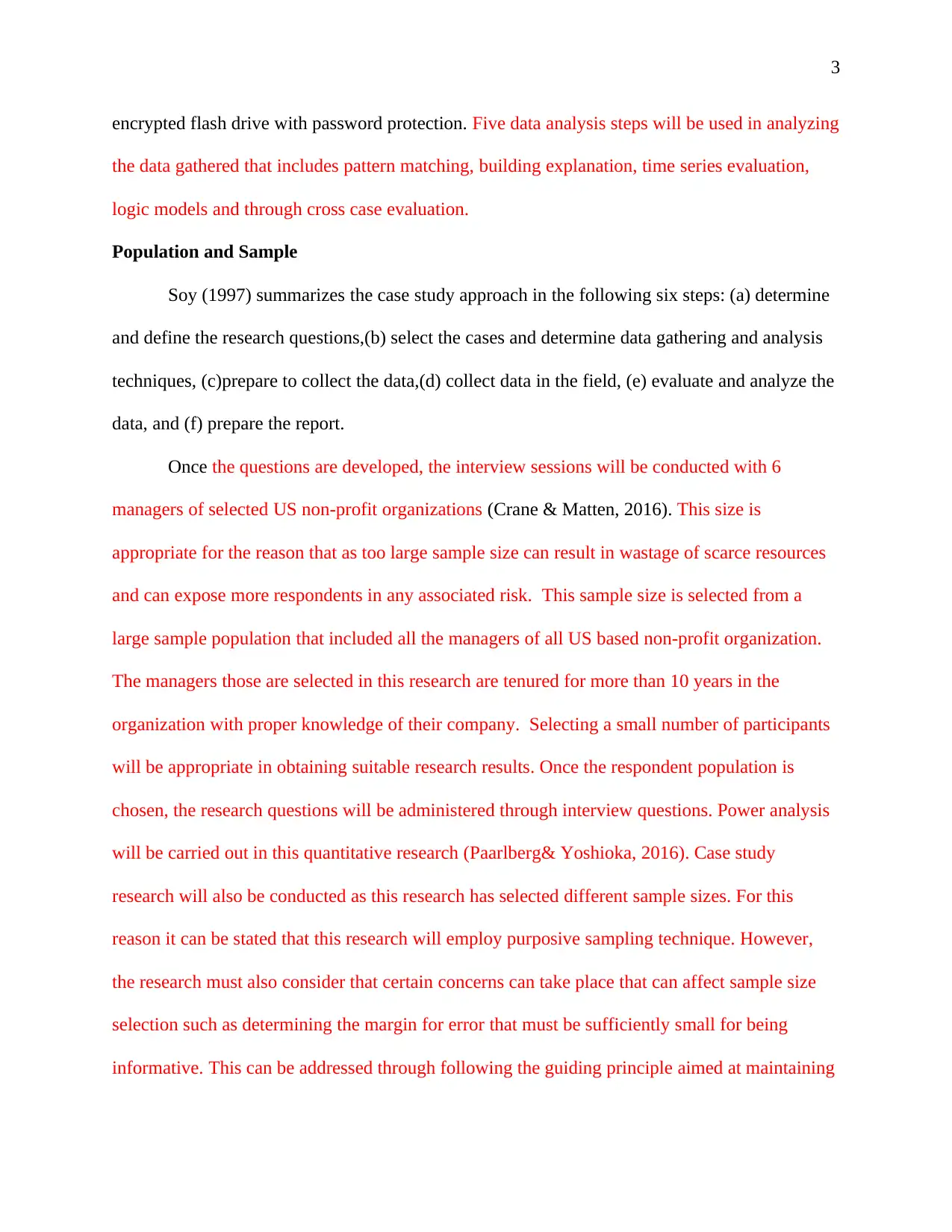
3
encrypted flash drive with password protection. Five data analysis steps will be used in analyzing
the data gathered that includes pattern matching, building explanation, time series evaluation,
logic models and through cross case evaluation.
Population and Sample
Soy (1997) summarizes the case study approach in the following six steps: (a) determine
and define the research questions,(b) select the cases and determine data gathering and analysis
techniques, (c)prepare to collect the data,(d) collect data in the field, (e) evaluate and analyze the
data, and (f) prepare the report.
Once the questions are developed, the interview sessions will be conducted with 6
managers of selected US non-profit organizations (Crane & Matten, 2016). This size is
appropriate for the reason that as too large sample size can result in wastage of scarce resources
and can expose more respondents in any associated risk. This sample size is selected from a
large sample population that included all the managers of all US based non-profit organization.
The managers those are selected in this research are tenured for more than 10 years in the
organization with proper knowledge of their company. Selecting a small number of participants
will be appropriate in obtaining suitable research results. Once the respondent population is
chosen, the research questions will be administered through interview questions. Power analysis
will be carried out in this quantitative research (Paarlberg& Yoshioka, 2016). Case study
research will also be conducted as this research has selected different sample sizes. For this
reason it can be stated that this research will employ purposive sampling technique. However,
the research must also consider that certain concerns can take place that can affect sample size
selection such as determining the margin for error that must be sufficiently small for being
informative. This can be addressed through following the guiding principle aimed at maintaining
encrypted flash drive with password protection. Five data analysis steps will be used in analyzing
the data gathered that includes pattern matching, building explanation, time series evaluation,
logic models and through cross case evaluation.
Population and Sample
Soy (1997) summarizes the case study approach in the following six steps: (a) determine
and define the research questions,(b) select the cases and determine data gathering and analysis
techniques, (c)prepare to collect the data,(d) collect data in the field, (e) evaluate and analyze the
data, and (f) prepare the report.
Once the questions are developed, the interview sessions will be conducted with 6
managers of selected US non-profit organizations (Crane & Matten, 2016). This size is
appropriate for the reason that as too large sample size can result in wastage of scarce resources
and can expose more respondents in any associated risk. This sample size is selected from a
large sample population that included all the managers of all US based non-profit organization.
The managers those are selected in this research are tenured for more than 10 years in the
organization with proper knowledge of their company. Selecting a small number of participants
will be appropriate in obtaining suitable research results. Once the respondent population is
chosen, the research questions will be administered through interview questions. Power analysis
will be carried out in this quantitative research (Paarlberg& Yoshioka, 2016). Case study
research will also be conducted as this research has selected different sample sizes. For this
reason it can be stated that this research will employ purposive sampling technique. However,
the research must also consider that certain concerns can take place that can affect sample size
selection such as determining the margin for error that must be sufficiently small for being
informative. This can be addressed through following the guiding principle aimed at maintaining
Paraphrase This Document
Need a fresh take? Get an instant paraphrase of this document with our AI Paraphraser
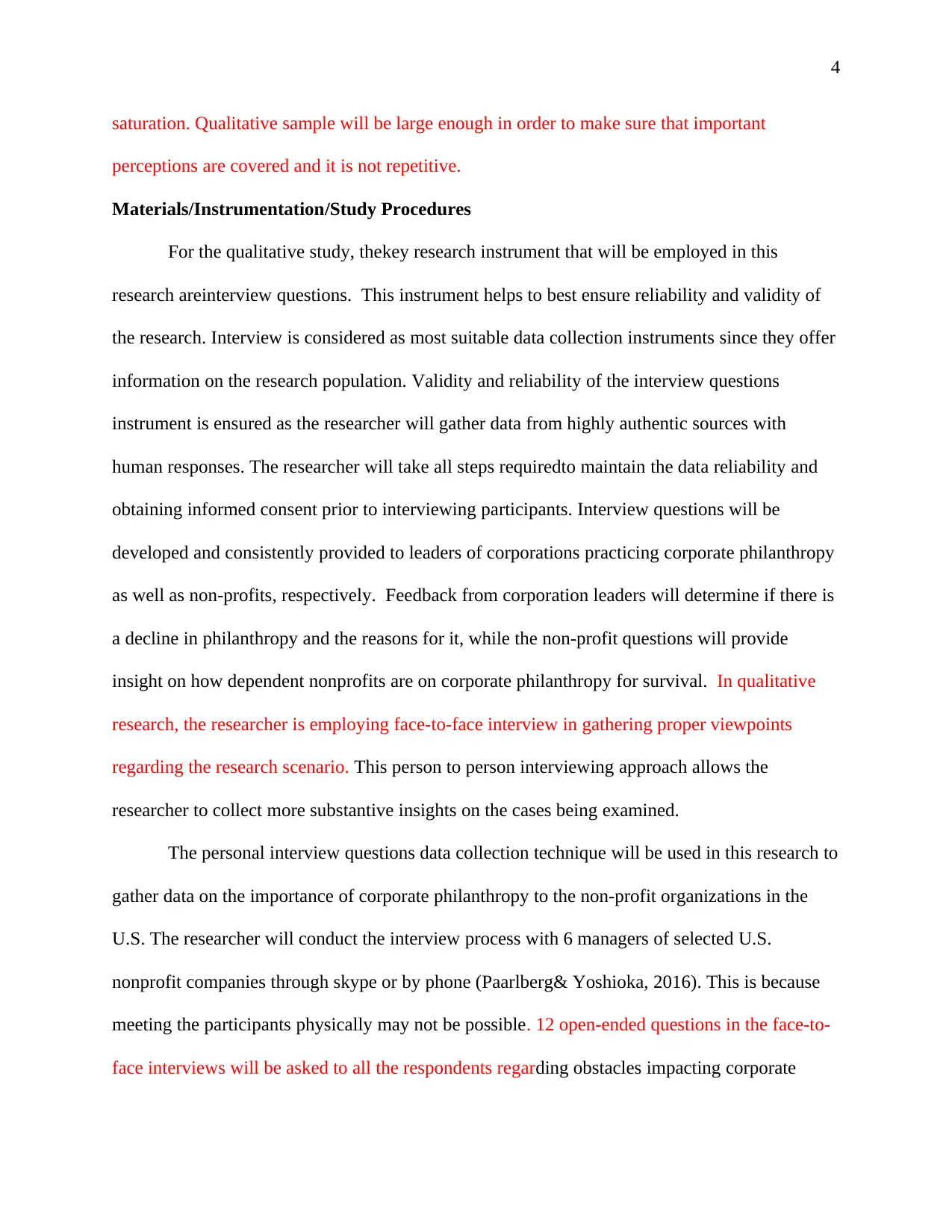
4
saturation. Qualitative sample will be large enough in order to make sure that important
perceptions are covered and it is not repetitive.
Materials/Instrumentation/Study Procedures
For the qualitative study, thekey research instrument that will be employed in this
research areinterview questions. This instrument helps to best ensure reliability and validity of
the research. Interview is considered as most suitable data collection instruments since they offer
information on the research population. Validity and reliability of the interview questions
instrument is ensured as the researcher will gather data from highly authentic sources with
human responses. The researcher will take all steps requiredto maintain the data reliability and
obtaining informed consent prior to interviewing participants. Interview questions will be
developed and consistently provided to leaders of corporations practicing corporate philanthropy
as well as non-profits, respectively. Feedback from corporation leaders will determine if there is
a decline in philanthropy and the reasons for it, while the non-profit questions will provide
insight on how dependent nonprofits are on corporate philanthropy for survival. In qualitative
research, the researcher is employing face-to-face interview in gathering proper viewpoints
regarding the research scenario. This person to person interviewing approach allows the
researcher to collect more substantive insights on the cases being examined.
The personal interview questions data collection technique will be used in this research to
gather data on the importance of corporate philanthropy to the non-profit organizations in the
U.S. The researcher will conduct the interview process with 6 managers of selected U.S.
nonprofit companies through skype or by phone (Paarlberg& Yoshioka, 2016). This is because
meeting the participants physically may not be possible. 12 open-ended questions in the face-to-
face interviews will be asked to all the respondents regarding obstacles impacting corporate
saturation. Qualitative sample will be large enough in order to make sure that important
perceptions are covered and it is not repetitive.
Materials/Instrumentation/Study Procedures
For the qualitative study, thekey research instrument that will be employed in this
research areinterview questions. This instrument helps to best ensure reliability and validity of
the research. Interview is considered as most suitable data collection instruments since they offer
information on the research population. Validity and reliability of the interview questions
instrument is ensured as the researcher will gather data from highly authentic sources with
human responses. The researcher will take all steps requiredto maintain the data reliability and
obtaining informed consent prior to interviewing participants. Interview questions will be
developed and consistently provided to leaders of corporations practicing corporate philanthropy
as well as non-profits, respectively. Feedback from corporation leaders will determine if there is
a decline in philanthropy and the reasons for it, while the non-profit questions will provide
insight on how dependent nonprofits are on corporate philanthropy for survival. In qualitative
research, the researcher is employing face-to-face interview in gathering proper viewpoints
regarding the research scenario. This person to person interviewing approach allows the
researcher to collect more substantive insights on the cases being examined.
The personal interview questions data collection technique will be used in this research to
gather data on the importance of corporate philanthropy to the non-profit organizations in the
U.S. The researcher will conduct the interview process with 6 managers of selected U.S.
nonprofit companies through skype or by phone (Paarlberg& Yoshioka, 2016). This is because
meeting the participants physically may not be possible. 12 open-ended questions in the face-to-
face interviews will be asked to all the respondents regarding obstacles impacting corporate
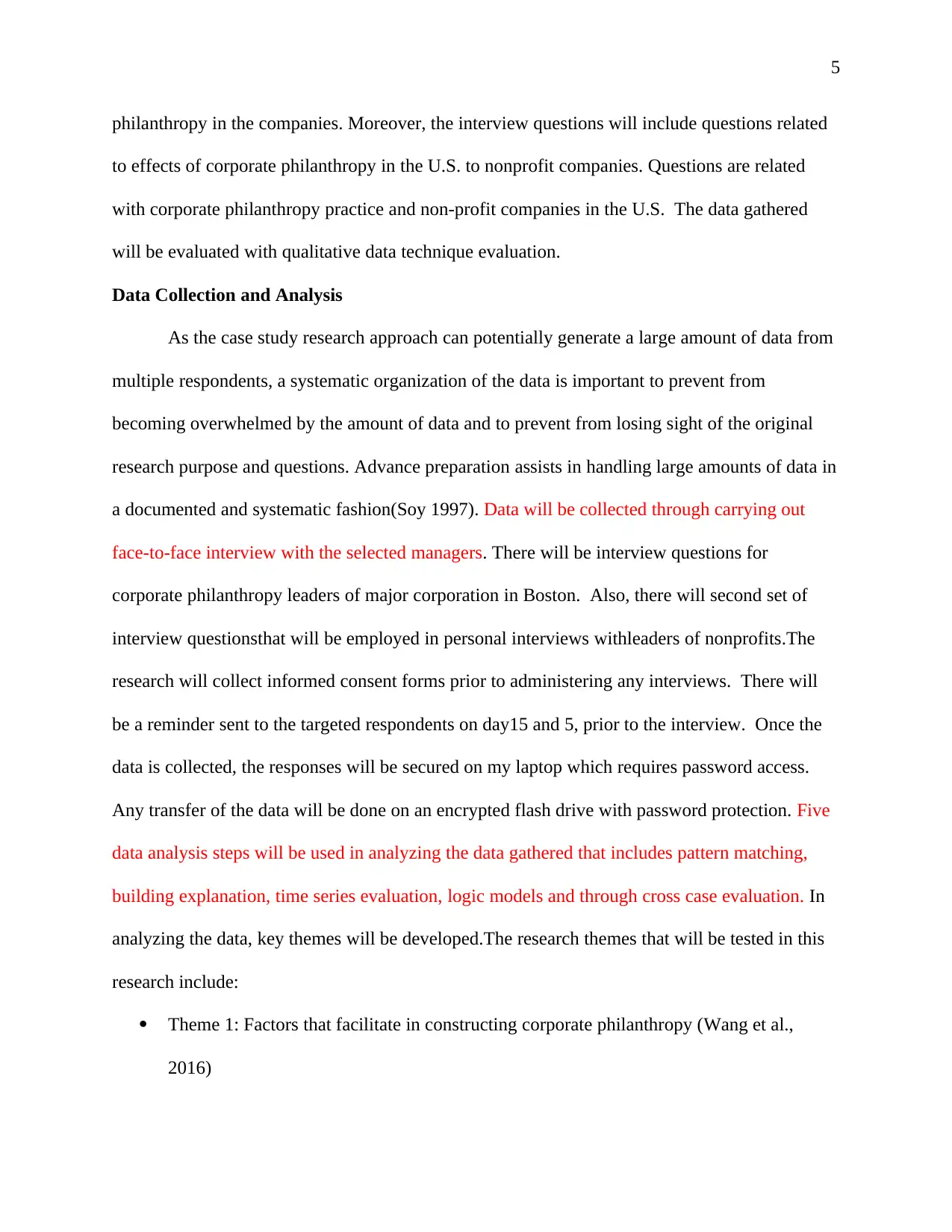
5
philanthropy in the companies. Moreover, the interview questions will include questions related
to effects of corporate philanthropy in the U.S. to nonprofit companies. Questions are related
with corporate philanthropy practice and non-profit companies in the U.S. The data gathered
will be evaluated with qualitative data technique evaluation.
Data Collection and Analysis
As the case study research approach can potentially generate a large amount of data from
multiple respondents, a systematic organization of the data is important to prevent from
becoming overwhelmed by the amount of data and to prevent from losing sight of the original
research purpose and questions. Advance preparation assists in handling large amounts of data in
a documented and systematic fashion(Soy 1997). Data will be collected through carrying out
face-to-face interview with the selected managers. There will be interview questions for
corporate philanthropy leaders of major corporation in Boston. Also, there will second set of
interview questionsthat will be employed in personal interviews withleaders of nonprofits.The
research will collect informed consent forms prior to administering any interviews. There will
be a reminder sent to the targeted respondents on day15 and 5, prior to the interview. Once the
data is collected, the responses will be secured on my laptop which requires password access.
Any transfer of the data will be done on an encrypted flash drive with password protection. Five
data analysis steps will be used in analyzing the data gathered that includes pattern matching,
building explanation, time series evaluation, logic models and through cross case evaluation. In
analyzing the data, key themes will be developed.The research themes that will be tested in this
research include:
Theme 1: Factors that facilitate in constructing corporate philanthropy (Wang et al.,
2016)
philanthropy in the companies. Moreover, the interview questions will include questions related
to effects of corporate philanthropy in the U.S. to nonprofit companies. Questions are related
with corporate philanthropy practice and non-profit companies in the U.S. The data gathered
will be evaluated with qualitative data technique evaluation.
Data Collection and Analysis
As the case study research approach can potentially generate a large amount of data from
multiple respondents, a systematic organization of the data is important to prevent from
becoming overwhelmed by the amount of data and to prevent from losing sight of the original
research purpose and questions. Advance preparation assists in handling large amounts of data in
a documented and systematic fashion(Soy 1997). Data will be collected through carrying out
face-to-face interview with the selected managers. There will be interview questions for
corporate philanthropy leaders of major corporation in Boston. Also, there will second set of
interview questionsthat will be employed in personal interviews withleaders of nonprofits.The
research will collect informed consent forms prior to administering any interviews. There will
be a reminder sent to the targeted respondents on day15 and 5, prior to the interview. Once the
data is collected, the responses will be secured on my laptop which requires password access.
Any transfer of the data will be done on an encrypted flash drive with password protection. Five
data analysis steps will be used in analyzing the data gathered that includes pattern matching,
building explanation, time series evaluation, logic models and through cross case evaluation. In
analyzing the data, key themes will be developed.The research themes that will be tested in this
research include:
Theme 1: Factors that facilitate in constructing corporate philanthropy (Wang et al.,
2016)
⊘ This is a preview!⊘
Do you want full access?
Subscribe today to unlock all pages.

Trusted by 1+ million students worldwide
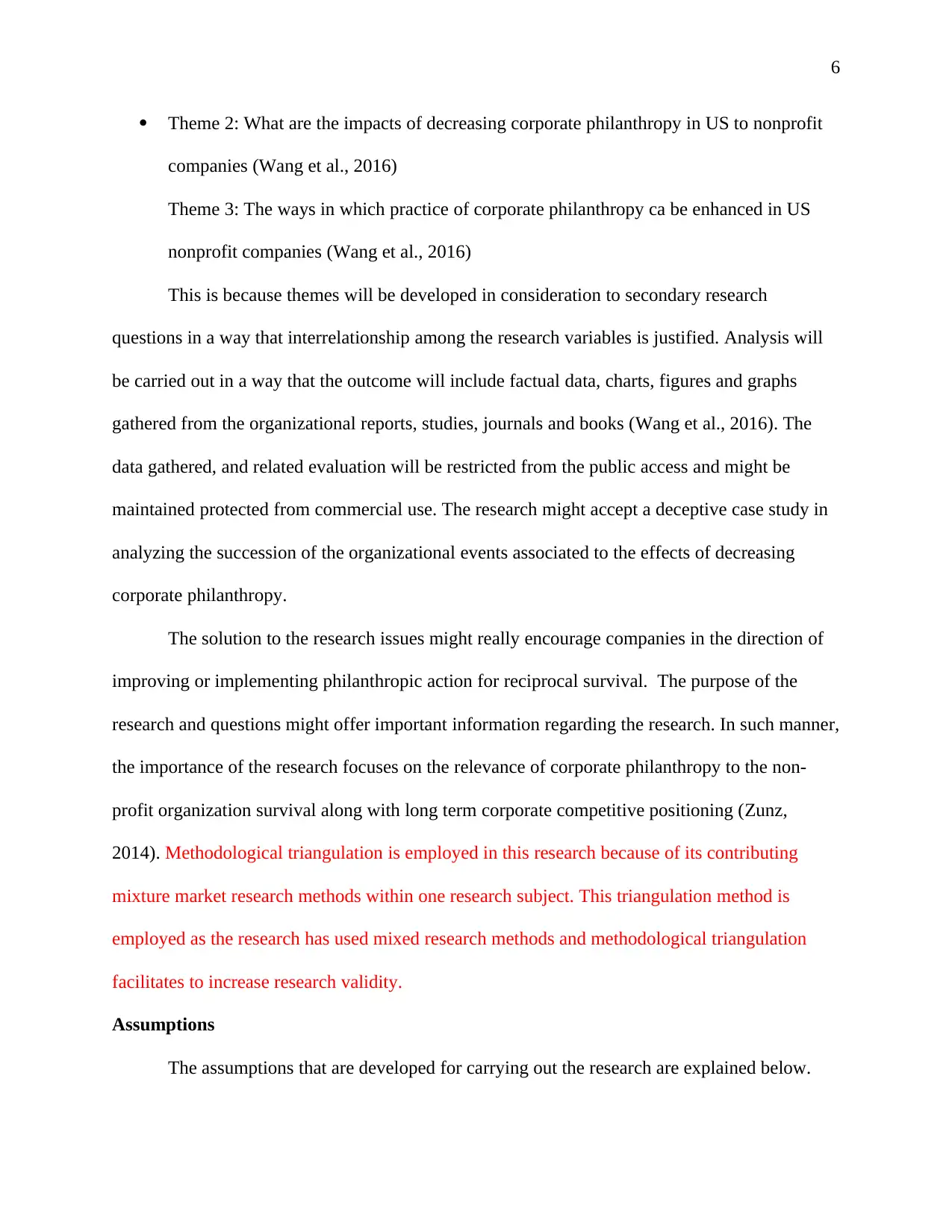
6
Theme 2: What are the impacts of decreasing corporate philanthropy in US to nonprofit
companies (Wang et al., 2016)
Theme 3: The ways in which practice of corporate philanthropy ca be enhanced in US
nonprofit companies (Wang et al., 2016)
This is because themes will be developed in consideration to secondary research
questions in a way that interrelationship among the research variables is justified. Analysis will
be carried out in a way that the outcome will include factual data, charts, figures and graphs
gathered from the organizational reports, studies, journals and books (Wang et al., 2016). The
data gathered, and related evaluation will be restricted from the public access and might be
maintained protected from commercial use. The research might accept a deceptive case study in
analyzing the succession of the organizational events associated to the effects of decreasing
corporate philanthropy.
The solution to the research issues might really encourage companies in the direction of
improving or implementing philanthropic action for reciprocal survival. The purpose of the
research and questions might offer important information regarding the research. In such manner,
the importance of the research focuses on the relevance of corporate philanthropy to the non-
profit organization survival along with long term corporate competitive positioning (Zunz,
2014). Methodological triangulation is employed in this research because of its contributing
mixture market research methods within one research subject. This triangulation method is
employed as the research has used mixed research methods and methodological triangulation
facilitates to increase research validity.
Assumptions
The assumptions that are developed for carrying out the research are explained below.
Theme 2: What are the impacts of decreasing corporate philanthropy in US to nonprofit
companies (Wang et al., 2016)
Theme 3: The ways in which practice of corporate philanthropy ca be enhanced in US
nonprofit companies (Wang et al., 2016)
This is because themes will be developed in consideration to secondary research
questions in a way that interrelationship among the research variables is justified. Analysis will
be carried out in a way that the outcome will include factual data, charts, figures and graphs
gathered from the organizational reports, studies, journals and books (Wang et al., 2016). The
data gathered, and related evaluation will be restricted from the public access and might be
maintained protected from commercial use. The research might accept a deceptive case study in
analyzing the succession of the organizational events associated to the effects of decreasing
corporate philanthropy.
The solution to the research issues might really encourage companies in the direction of
improving or implementing philanthropic action for reciprocal survival. The purpose of the
research and questions might offer important information regarding the research. In such manner,
the importance of the research focuses on the relevance of corporate philanthropy to the non-
profit organization survival along with long term corporate competitive positioning (Zunz,
2014). Methodological triangulation is employed in this research because of its contributing
mixture market research methods within one research subject. This triangulation method is
employed as the research has used mixed research methods and methodological triangulation
facilitates to increase research validity.
Assumptions
The assumptions that are developed for carrying out the research are explained below.
Paraphrase This Document
Need a fresh take? Get an instant paraphrase of this document with our AI Paraphraser
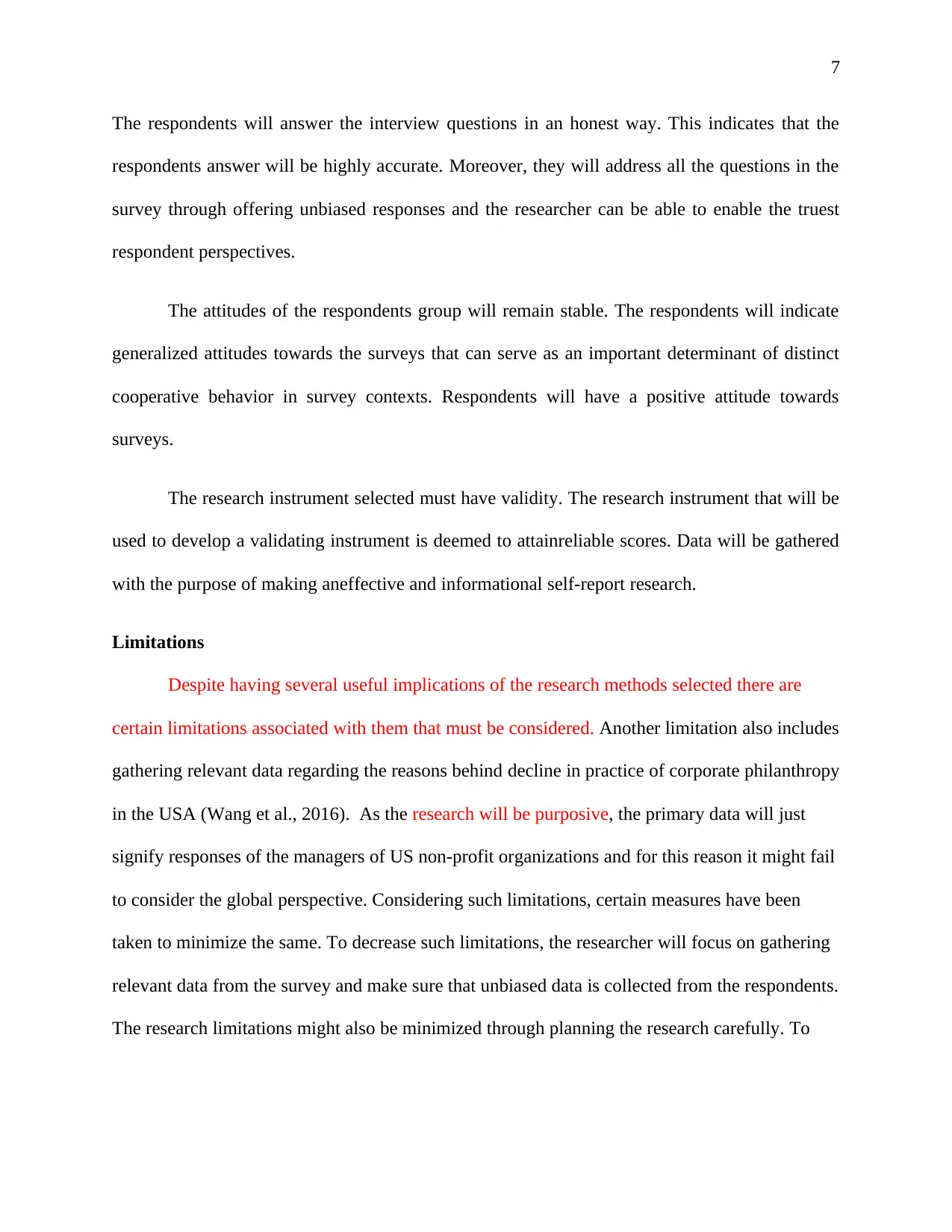
7
The respondents will answer the interview questions in an honest way. This indicates that the
respondents answer will be highly accurate. Moreover, they will address all the questions in the
survey through offering unbiased responses and the researcher can be able to enable the truest
respondent perspectives.
The attitudes of the respondents group will remain stable. The respondents will indicate
generalized attitudes towards the surveys that can serve as an important determinant of distinct
cooperative behavior in survey contexts. Respondents will have a positive attitude towards
surveys.
The research instrument selected must have validity. The research instrument that will be
used to develop a validating instrument is deemed to attainreliable scores. Data will be gathered
with the purpose of making aneffective and informational self-report research.
Limitations
Despite having several useful implications of the research methods selected there are
certain limitations associated with them that must be considered. Another limitation also includes
gathering relevant data regarding the reasons behind decline in practice of corporate philanthropy
in the USA (Wang et al., 2016). As the research will be purposive, the primary data will just
signify responses of the managers of US non-profit organizations and for this reason it might fail
to consider the global perspective. Considering such limitations, certain measures have been
taken to minimize the same. To decrease such limitations, the researcher will focus on gathering
relevant data from the survey and make sure that unbiased data is collected from the respondents.
The research limitations might also be minimized through planning the research carefully. To
The respondents will answer the interview questions in an honest way. This indicates that the
respondents answer will be highly accurate. Moreover, they will address all the questions in the
survey through offering unbiased responses and the researcher can be able to enable the truest
respondent perspectives.
The attitudes of the respondents group will remain stable. The respondents will indicate
generalized attitudes towards the surveys that can serve as an important determinant of distinct
cooperative behavior in survey contexts. Respondents will have a positive attitude towards
surveys.
The research instrument selected must have validity. The research instrument that will be
used to develop a validating instrument is deemed to attainreliable scores. Data will be gathered
with the purpose of making aneffective and informational self-report research.
Limitations
Despite having several useful implications of the research methods selected there are
certain limitations associated with them that must be considered. Another limitation also includes
gathering relevant data regarding the reasons behind decline in practice of corporate philanthropy
in the USA (Wang et al., 2016). As the research will be purposive, the primary data will just
signify responses of the managers of US non-profit organizations and for this reason it might fail
to consider the global perspective. Considering such limitations, certain measures have been
taken to minimize the same. To decrease such limitations, the researcher will focus on gathering
relevant data from the survey and make sure that unbiased data is collected from the respondents.
The research limitations might also be minimized through planning the research carefully. To
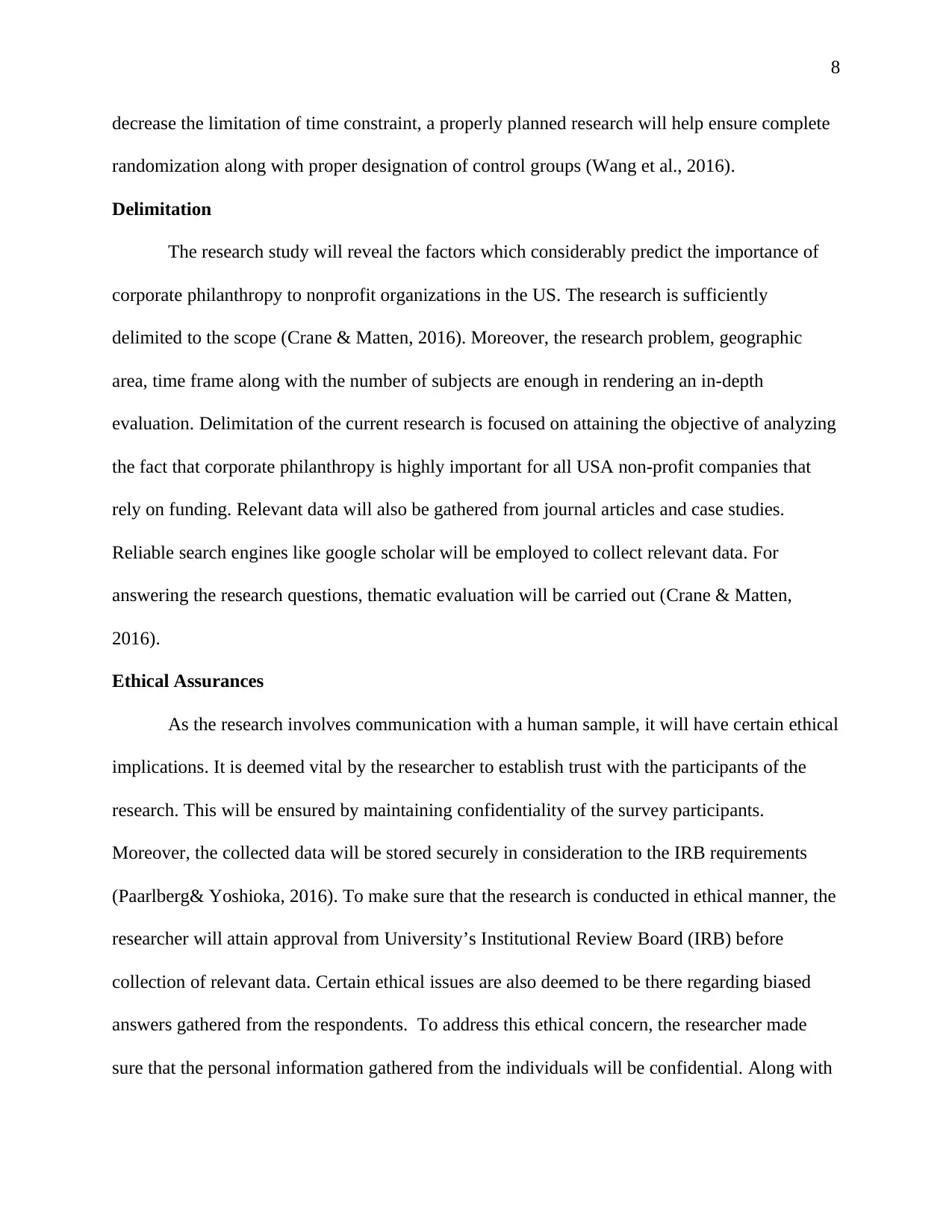
8
decrease the limitation of time constraint, a properly planned research will help ensure complete
randomization along with proper designation of control groups (Wang et al., 2016).
Delimitation
The research study will reveal the factors which considerably predict the importance of
corporate philanthropy to nonprofit organizations in the US. The research is sufficiently
delimited to the scope (Crane & Matten, 2016). Moreover, the research problem, geographic
area, time frame along with the number of subjects are enough in rendering an in-depth
evaluation. Delimitation of the current research is focused on attaining the objective of analyzing
the fact that corporate philanthropy is highly important for all USA non-profit companies that
rely on funding. Relevant data will also be gathered from journal articles and case studies.
Reliable search engines like google scholar will be employed to collect relevant data. For
answering the research questions, thematic evaluation will be carried out (Crane & Matten,
2016).
Ethical Assurances
As the research involves communication with a human sample, it will have certain ethical
implications. It is deemed vital by the researcher to establish trust with the participants of the
research. This will be ensured by maintaining confidentiality of the survey participants.
Moreover, the collected data will be stored securely in consideration to the IRB requirements
(Paarlberg& Yoshioka, 2016). To make sure that the research is conducted in ethical manner, the
researcher will attain approval from University’s Institutional Review Board (IRB) before
collection of relevant data. Certain ethical issues are also deemed to be there regarding biased
answers gathered from the respondents. To address this ethical concern, the researcher made
sure that the personal information gathered from the individuals will be confidential. Along with
decrease the limitation of time constraint, a properly planned research will help ensure complete
randomization along with proper designation of control groups (Wang et al., 2016).
Delimitation
The research study will reveal the factors which considerably predict the importance of
corporate philanthropy to nonprofit organizations in the US. The research is sufficiently
delimited to the scope (Crane & Matten, 2016). Moreover, the research problem, geographic
area, time frame along with the number of subjects are enough in rendering an in-depth
evaluation. Delimitation of the current research is focused on attaining the objective of analyzing
the fact that corporate philanthropy is highly important for all USA non-profit companies that
rely on funding. Relevant data will also be gathered from journal articles and case studies.
Reliable search engines like google scholar will be employed to collect relevant data. For
answering the research questions, thematic evaluation will be carried out (Crane & Matten,
2016).
Ethical Assurances
As the research involves communication with a human sample, it will have certain ethical
implications. It is deemed vital by the researcher to establish trust with the participants of the
research. This will be ensured by maintaining confidentiality of the survey participants.
Moreover, the collected data will be stored securely in consideration to the IRB requirements
(Paarlberg& Yoshioka, 2016). To make sure that the research is conducted in ethical manner, the
researcher will attain approval from University’s Institutional Review Board (IRB) before
collection of relevant data. Certain ethical issues are also deemed to be there regarding biased
answers gathered from the respondents. To address this ethical concern, the researcher made
sure that the personal information gathered from the individuals will be confidential. Along with
⊘ This is a preview!⊘
Do you want full access?
Subscribe today to unlock all pages.

Trusted by 1+ million students worldwide
1 out of 20
Related Documents
Your All-in-One AI-Powered Toolkit for Academic Success.
+13062052269
info@desklib.com
Available 24*7 on WhatsApp / Email
![[object Object]](/_next/static/media/star-bottom.7253800d.svg)
Unlock your academic potential
Copyright © 2020–2025 A2Z Services. All Rights Reserved. Developed and managed by ZUCOL.





